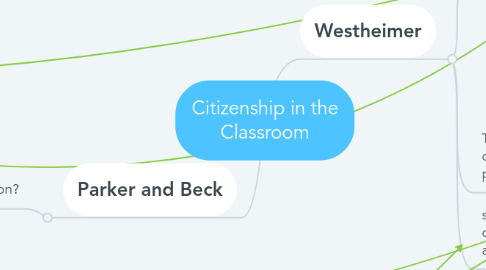
1. Parker and Beck
1.1. Why Citizenship/Democratic Education?
1.1.1. There can be no democracy
1.1.2. Expectations of a Democracy:
1.1.2.1. Solving problems, making policy
1.1.2.2. Protecting civil rights
1.1.2.3. Ensuring liberties of people to express unpopular opinions
1.1.3. Without Democratic Education:
1.1.3.1. Despite expectations, democracy is a fragile social system
1.1.3.2. James Baldwin: if children are not educated to live democratically they could possibly become the next generation to commit a Holocaust.
1.1.3.3. Citizenship education is often overlooked to ensure better standard test scores
1.1.4. With Democratic Education:
1.1.4.1. Educate children with the ideals of a democracy and encourage them to work steadily to transform those ideals into realities
1.1.4.2. Citizens can think critically and resolve disputes in non-violent ways and cooperate with people they do not like and tolerate religious/political views different from theirs.
1.1.5. Teachers should encourage students to solve small group problems in a cooperative matter. Engage them in a polite discussion, decision making, and civic responsibilities
2. Westheimer
2.1. Democratic Patriotism
2.1.1. Commitment not only to the government, and its leaders, but to the people, principles, and values that underlie democracy
2.1.2. Political participation, free speech, civil liberties, political equality
2.1.3. Liberty and justice for all actually means liberty and justice for all and is a guiding principal to programs and policies
2.1.4. How to teach about patriotism
2.1.4.1. encourage students to ask questions, think about their commitments to their local and national and global communities
2.1.4.2. provide students with information about how they can think about patriotism in a substantive way
2.1.4.3. root instruction in local contexts, working within their own specific surroundings and circumstances
